HRM 7 Portfolio Report: Analysis of HRM Issues, Spring 2019, UTS
VerifiedAdded on 2022/09/15
|8
|1901
|17
Report
AI Summary
This HRM portfolio report addresses several key issues in contemporary human resource management, focusing on the Australian context. The report examines the gender pay gap, highlighting discrimination as a significant contributor to inequality, and analyzes its implications for HRM policies. It also explores the impact of technological changes on the workplace, including the rise of the gig economy and increasing self-employment, and discusses the challenges and opportunities these changes present for HR managers. Furthermore, the report touches upon the aging workforce in Australia, the role of HR in improving worker productivity, and ethical issues facing organizations. The report provides a detailed analysis of these issues, drawing on academic sources and real-world examples to provide a comprehensive overview of current HRM challenges and strategies.
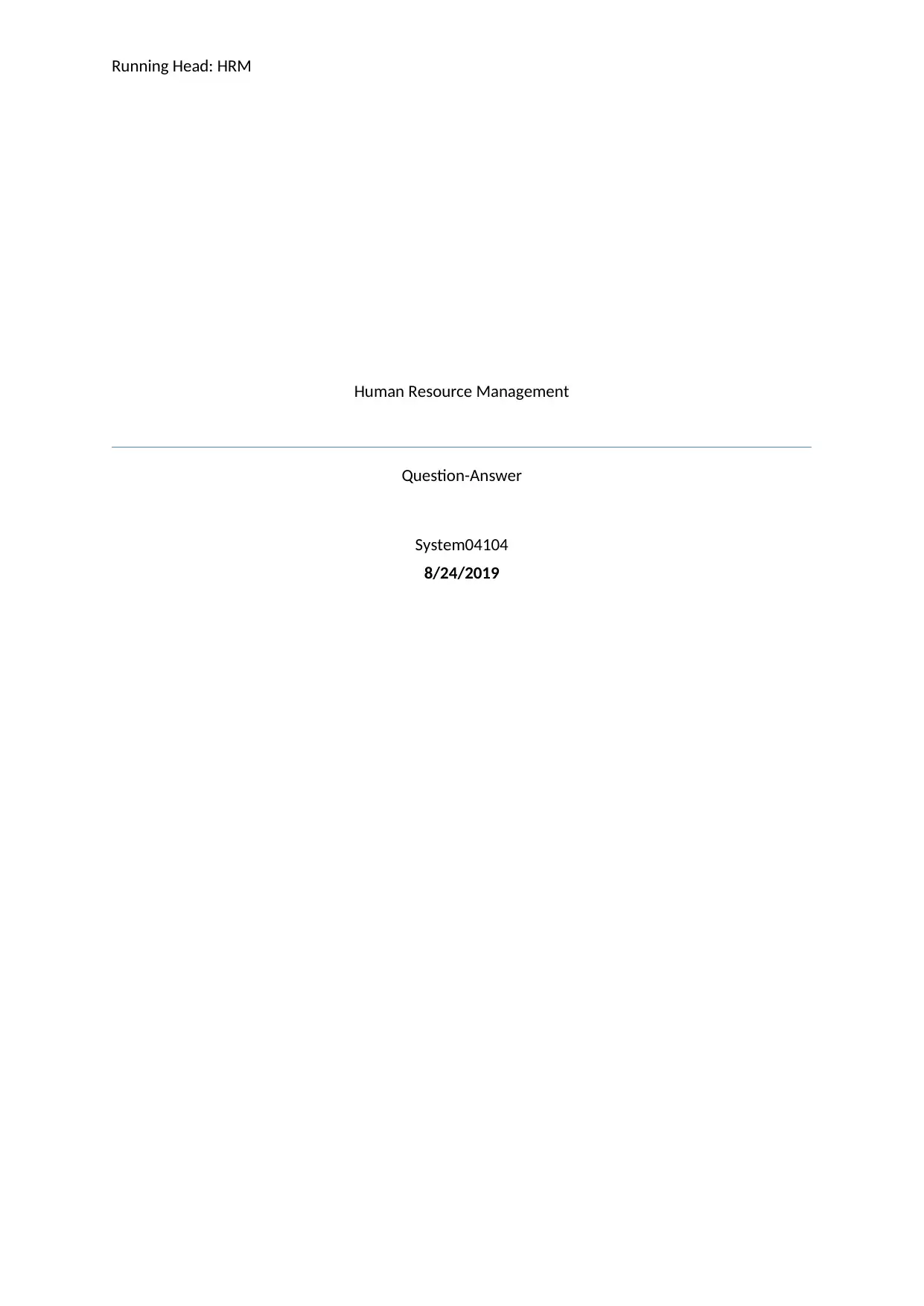
Running Head: HRM
Human Resource Management
Question-Answer
System04104
8/24/2019
Human Resource Management
Question-Answer
System04104
8/24/2019
Paraphrase This Document
Need a fresh take? Get an instant paraphrase of this document with our AI Paraphraser
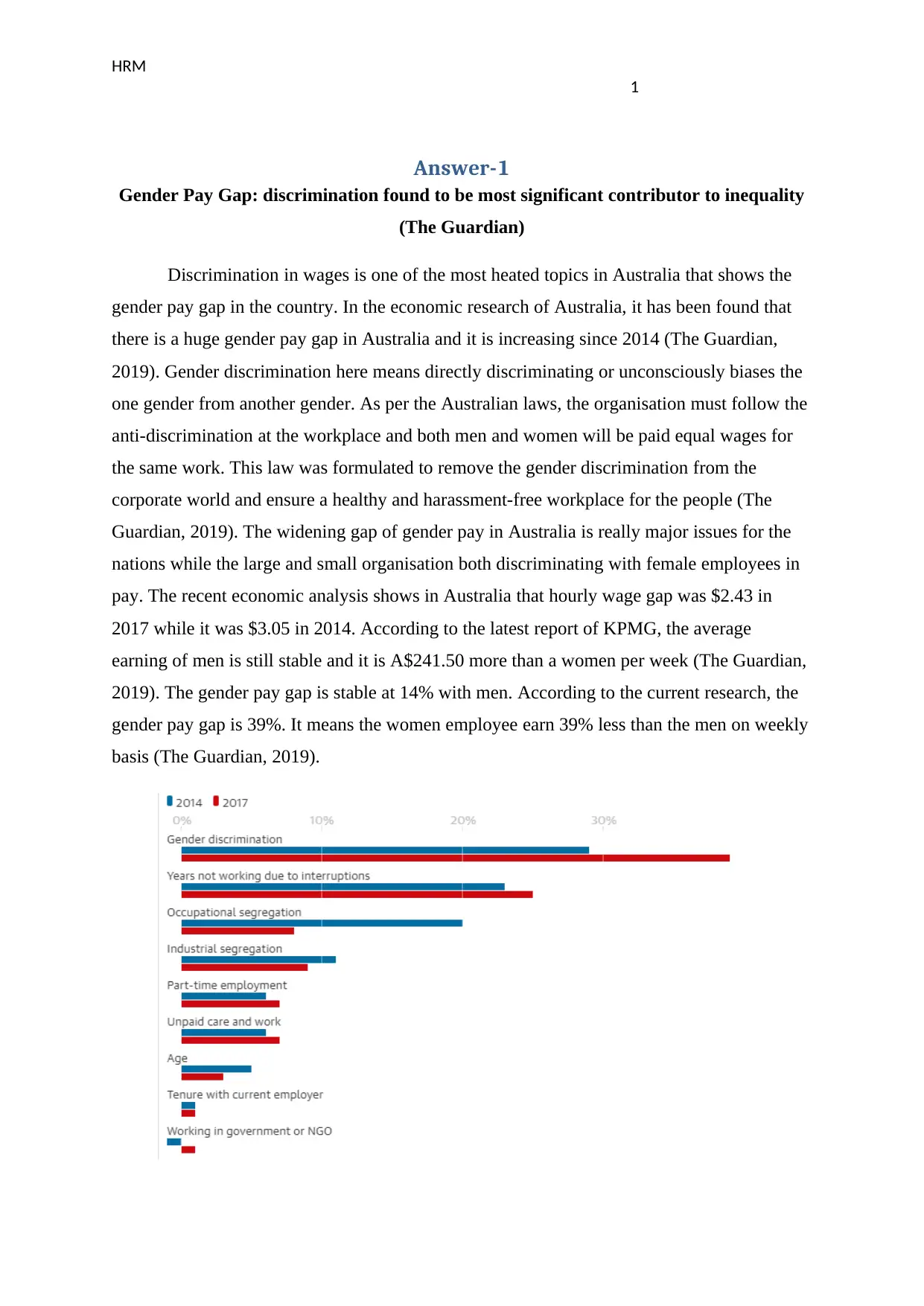
HRM
1
Answer-1
Gender Pay Gap: discrimination found to be most significant contributor to inequality
(The Guardian)
Discrimination in wages is one of the most heated topics in Australia that shows the
gender pay gap in the country. In the economic research of Australia, it has been found that
there is a huge gender pay gap in Australia and it is increasing since 2014 (The Guardian,
2019). Gender discrimination here means directly discriminating or unconsciously biases the
one gender from another gender. As per the Australian laws, the organisation must follow the
anti-discrimination at the workplace and both men and women will be paid equal wages for
the same work. This law was formulated to remove the gender discrimination from the
corporate world and ensure a healthy and harassment-free workplace for the people (The
Guardian, 2019). The widening gap of gender pay in Australia is really major issues for the
nations while the large and small organisation both discriminating with female employees in
pay. The recent economic analysis shows in Australia that hourly wage gap was $2.43 in
2017 while it was $3.05 in 2014. According to the latest report of KPMG, the average
earning of men is still stable and it is A$241.50 more than a women per week (The Guardian,
2019). The gender pay gap is stable at 14% with men. According to the current research, the
gender pay gap is 39%. It means the women employee earn 39% less than the men on weekly
basis (The Guardian, 2019).
1
Answer-1
Gender Pay Gap: discrimination found to be most significant contributor to inequality
(The Guardian)
Discrimination in wages is one of the most heated topics in Australia that shows the
gender pay gap in the country. In the economic research of Australia, it has been found that
there is a huge gender pay gap in Australia and it is increasing since 2014 (The Guardian,
2019). Gender discrimination here means directly discriminating or unconsciously biases the
one gender from another gender. As per the Australian laws, the organisation must follow the
anti-discrimination at the workplace and both men and women will be paid equal wages for
the same work. This law was formulated to remove the gender discrimination from the
corporate world and ensure a healthy and harassment-free workplace for the people (The
Guardian, 2019). The widening gap of gender pay in Australia is really major issues for the
nations while the large and small organisation both discriminating with female employees in
pay. The recent economic analysis shows in Australia that hourly wage gap was $2.43 in
2017 while it was $3.05 in 2014. According to the latest report of KPMG, the average
earning of men is still stable and it is A$241.50 more than a women per week (The Guardian,
2019). The gender pay gap is stable at 14% with men. According to the current research, the
gender pay gap is 39%. It means the women employee earn 39% less than the men on weekly
basis (The Guardian, 2019).
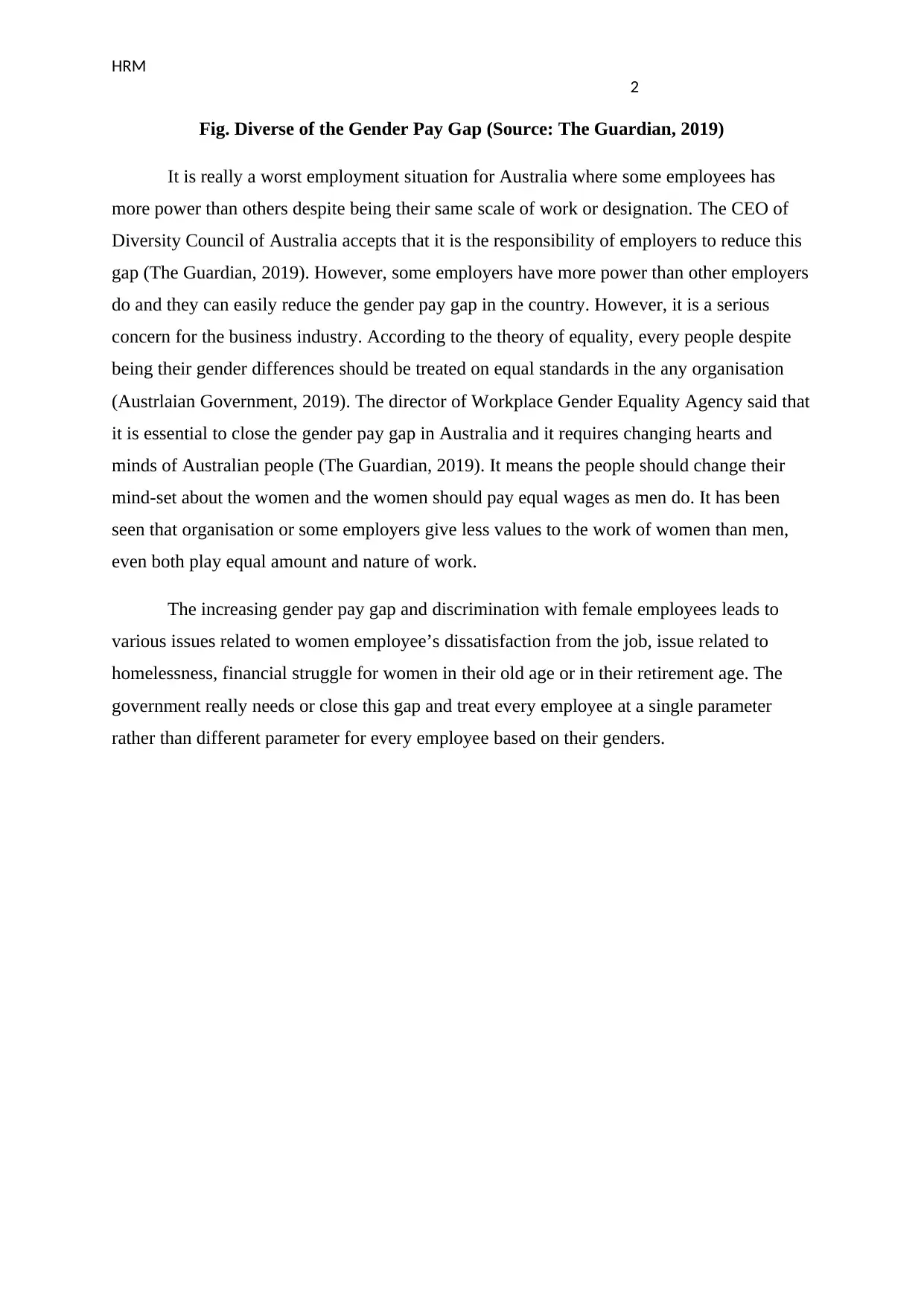
HRM
2
Fig. Diverse of the Gender Pay Gap (Source: The Guardian, 2019)
It is really a worst employment situation for Australia where some employees has
more power than others despite being their same scale of work or designation. The CEO of
Diversity Council of Australia accepts that it is the responsibility of employers to reduce this
gap (The Guardian, 2019). However, some employers have more power than other employers
do and they can easily reduce the gender pay gap in the country. However, it is a serious
concern for the business industry. According to the theory of equality, every people despite
being their gender differences should be treated on equal standards in the any organisation
(Austrlaian Government, 2019). The director of Workplace Gender Equality Agency said that
it is essential to close the gender pay gap in Australia and it requires changing hearts and
minds of Australian people (The Guardian, 2019). It means the people should change their
mind-set about the women and the women should pay equal wages as men do. It has been
seen that organisation or some employers give less values to the work of women than men,
even both play equal amount and nature of work.
The increasing gender pay gap and discrimination with female employees leads to
various issues related to women employee’s dissatisfaction from the job, issue related to
homelessness, financial struggle for women in their old age or in their retirement age. The
government really needs or close this gap and treat every employee at a single parameter
rather than different parameter for every employee based on their genders.
2
Fig. Diverse of the Gender Pay Gap (Source: The Guardian, 2019)
It is really a worst employment situation for Australia where some employees has
more power than others despite being their same scale of work or designation. The CEO of
Diversity Council of Australia accepts that it is the responsibility of employers to reduce this
gap (The Guardian, 2019). However, some employers have more power than other employers
do and they can easily reduce the gender pay gap in the country. However, it is a serious
concern for the business industry. According to the theory of equality, every people despite
being their gender differences should be treated on equal standards in the any organisation
(Austrlaian Government, 2019). The director of Workplace Gender Equality Agency said that
it is essential to close the gender pay gap in Australia and it requires changing hearts and
minds of Australian people (The Guardian, 2019). It means the people should change their
mind-set about the women and the women should pay equal wages as men do. It has been
seen that organisation or some employers give less values to the work of women than men,
even both play equal amount and nature of work.
The increasing gender pay gap and discrimination with female employees leads to
various issues related to women employee’s dissatisfaction from the job, issue related to
homelessness, financial struggle for women in their old age or in their retirement age. The
government really needs or close this gap and treat every employee at a single parameter
rather than different parameter for every employee based on their genders.
⊘ This is a preview!⊘
Do you want full access?
Subscribe today to unlock all pages.

Trusted by 1+ million students worldwide
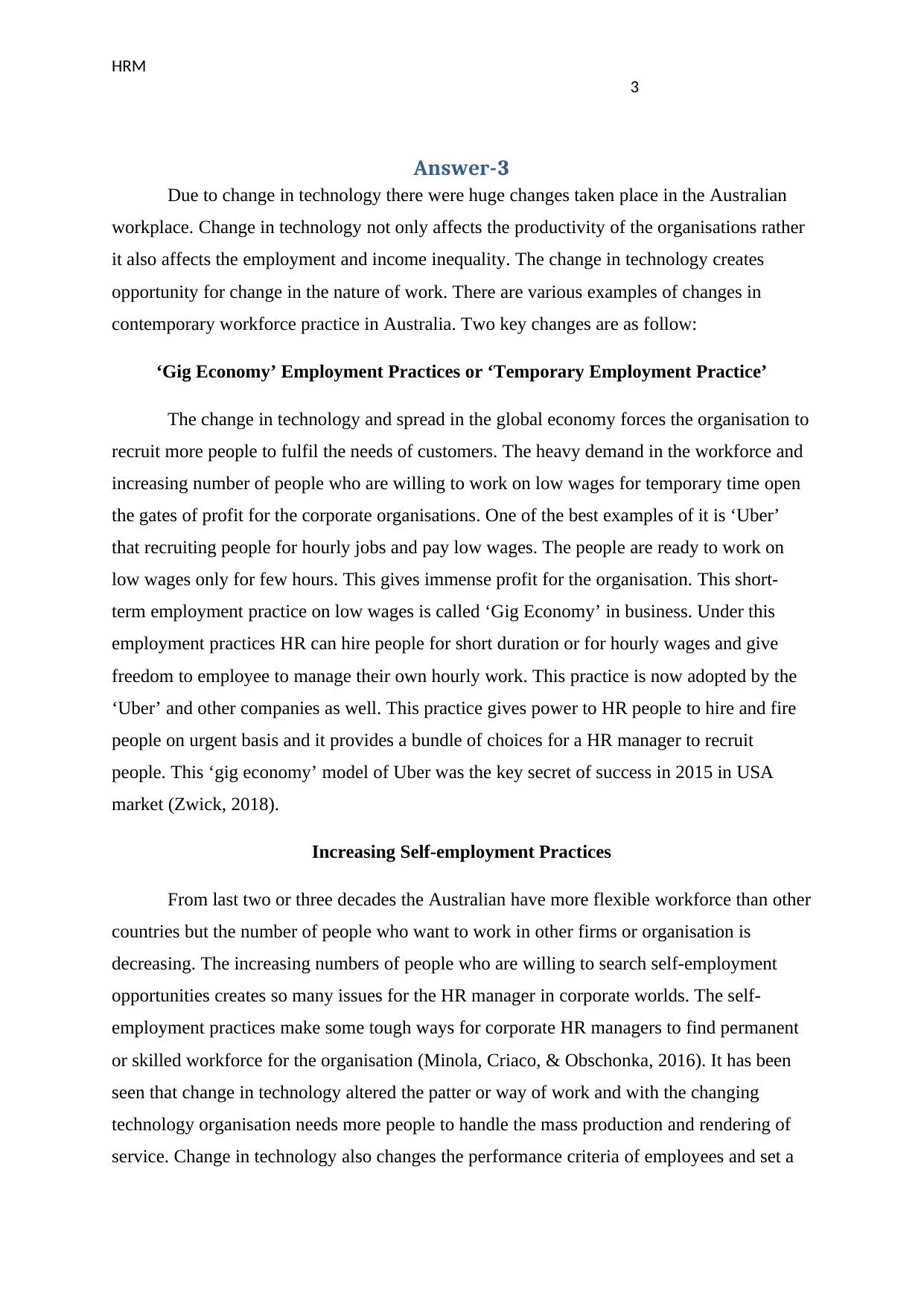
HRM
3
Answer-3
Due to change in technology there were huge changes taken place in the Australian
workplace. Change in technology not only affects the productivity of the organisations rather
it also affects the employment and income inequality. The change in technology creates
opportunity for change in the nature of work. There are various examples of changes in
contemporary workforce practice in Australia. Two key changes are as follow:
‘Gig Economy’ Employment Practices or ‘Temporary Employment Practice’
The change in technology and spread in the global economy forces the organisation to
recruit more people to fulfil the needs of customers. The heavy demand in the workforce and
increasing number of people who are willing to work on low wages for temporary time open
the gates of profit for the corporate organisations. One of the best examples of it is ‘Uber’
that recruiting people for hourly jobs and pay low wages. The people are ready to work on
low wages only for few hours. This gives immense profit for the organisation. This short-
term employment practice on low wages is called ‘Gig Economy’ in business. Under this
employment practices HR can hire people for short duration or for hourly wages and give
freedom to employee to manage their own hourly work. This practice is now adopted by the
‘Uber’ and other companies as well. This practice gives power to HR people to hire and fire
people on urgent basis and it provides a bundle of choices for a HR manager to recruit
people. This ‘gig economy’ model of Uber was the key secret of success in 2015 in USA
market (Zwick, 2018).
Increasing Self-employment Practices
From last two or three decades the Australian have more flexible workforce than other
countries but the number of people who want to work in other firms or organisation is
decreasing. The increasing numbers of people who are willing to search self-employment
opportunities creates so many issues for the HR manager in corporate worlds. The self-
employment practices make some tough ways for corporate HR managers to find permanent
or skilled workforce for the organisation (Minola, Criaco, & Obschonka, 2016). It has been
seen that change in technology altered the patter or way of work and with the changing
technology organisation needs more people to handle the mass production and rendering of
service. Change in technology also changes the performance criteria of employees and set a
3
Answer-3
Due to change in technology there were huge changes taken place in the Australian
workplace. Change in technology not only affects the productivity of the organisations rather
it also affects the employment and income inequality. The change in technology creates
opportunity for change in the nature of work. There are various examples of changes in
contemporary workforce practice in Australia. Two key changes are as follow:
‘Gig Economy’ Employment Practices or ‘Temporary Employment Practice’
The change in technology and spread in the global economy forces the organisation to
recruit more people to fulfil the needs of customers. The heavy demand in the workforce and
increasing number of people who are willing to work on low wages for temporary time open
the gates of profit for the corporate organisations. One of the best examples of it is ‘Uber’
that recruiting people for hourly jobs and pay low wages. The people are ready to work on
low wages only for few hours. This gives immense profit for the organisation. This short-
term employment practice on low wages is called ‘Gig Economy’ in business. Under this
employment practices HR can hire people for short duration or for hourly wages and give
freedom to employee to manage their own hourly work. This practice is now adopted by the
‘Uber’ and other companies as well. This practice gives power to HR people to hire and fire
people on urgent basis and it provides a bundle of choices for a HR manager to recruit
people. This ‘gig economy’ model of Uber was the key secret of success in 2015 in USA
market (Zwick, 2018).
Increasing Self-employment Practices
From last two or three decades the Australian have more flexible workforce than other
countries but the number of people who want to work in other firms or organisation is
decreasing. The increasing numbers of people who are willing to search self-employment
opportunities creates so many issues for the HR manager in corporate worlds. The self-
employment practices make some tough ways for corporate HR managers to find permanent
or skilled workforce for the organisation (Minola, Criaco, & Obschonka, 2016). It has been
seen that change in technology altered the patter or way of work and with the changing
technology organisation needs more people to handle the mass production and rendering of
service. Change in technology also changes the performance criteria of employees and set a
Paraphrase This Document
Need a fresh take? Get an instant paraphrase of this document with our AI Paraphraser
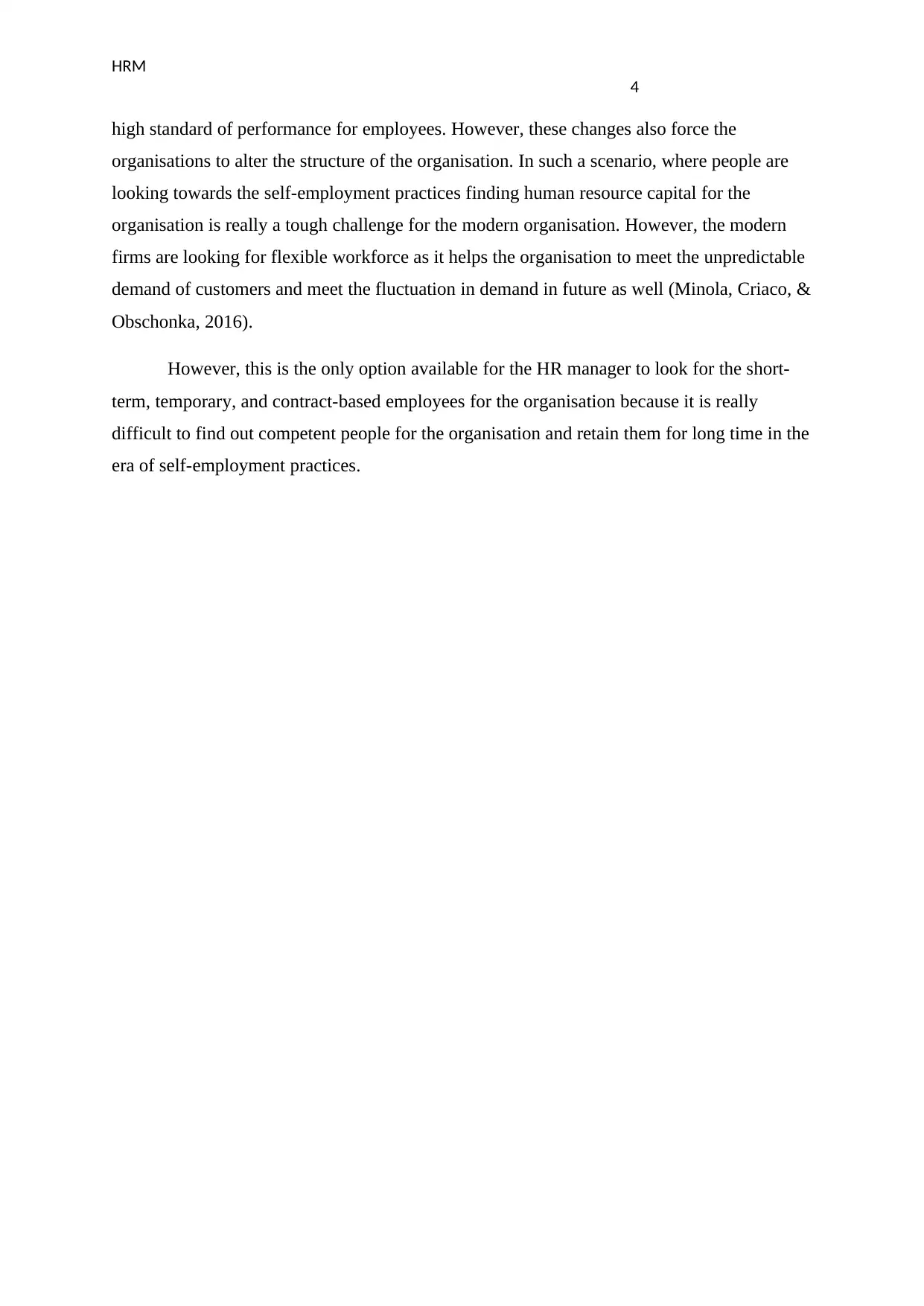
HRM
4
high standard of performance for employees. However, these changes also force the
organisations to alter the structure of the organisation. In such a scenario, where people are
looking towards the self-employment practices finding human resource capital for the
organisation is really a tough challenge for the modern organisation. However, the modern
firms are looking for flexible workforce as it helps the organisation to meet the unpredictable
demand of customers and meet the fluctuation in demand in future as well (Minola, Criaco, &
Obschonka, 2016).
However, this is the only option available for the HR manager to look for the short-
term, temporary, and contract-based employees for the organisation because it is really
difficult to find out competent people for the organisation and retain them for long time in the
era of self-employment practices.
4
high standard of performance for employees. However, these changes also force the
organisations to alter the structure of the organisation. In such a scenario, where people are
looking towards the self-employment practices finding human resource capital for the
organisation is really a tough challenge for the modern organisation. However, the modern
firms are looking for flexible workforce as it helps the organisation to meet the unpredictable
demand of customers and meet the fluctuation in demand in future as well (Minola, Criaco, &
Obschonka, 2016).
However, this is the only option available for the HR manager to look for the short-
term, temporary, and contract-based employees for the organisation because it is really
difficult to find out competent people for the organisation and retain them for long time in the
era of self-employment practices.
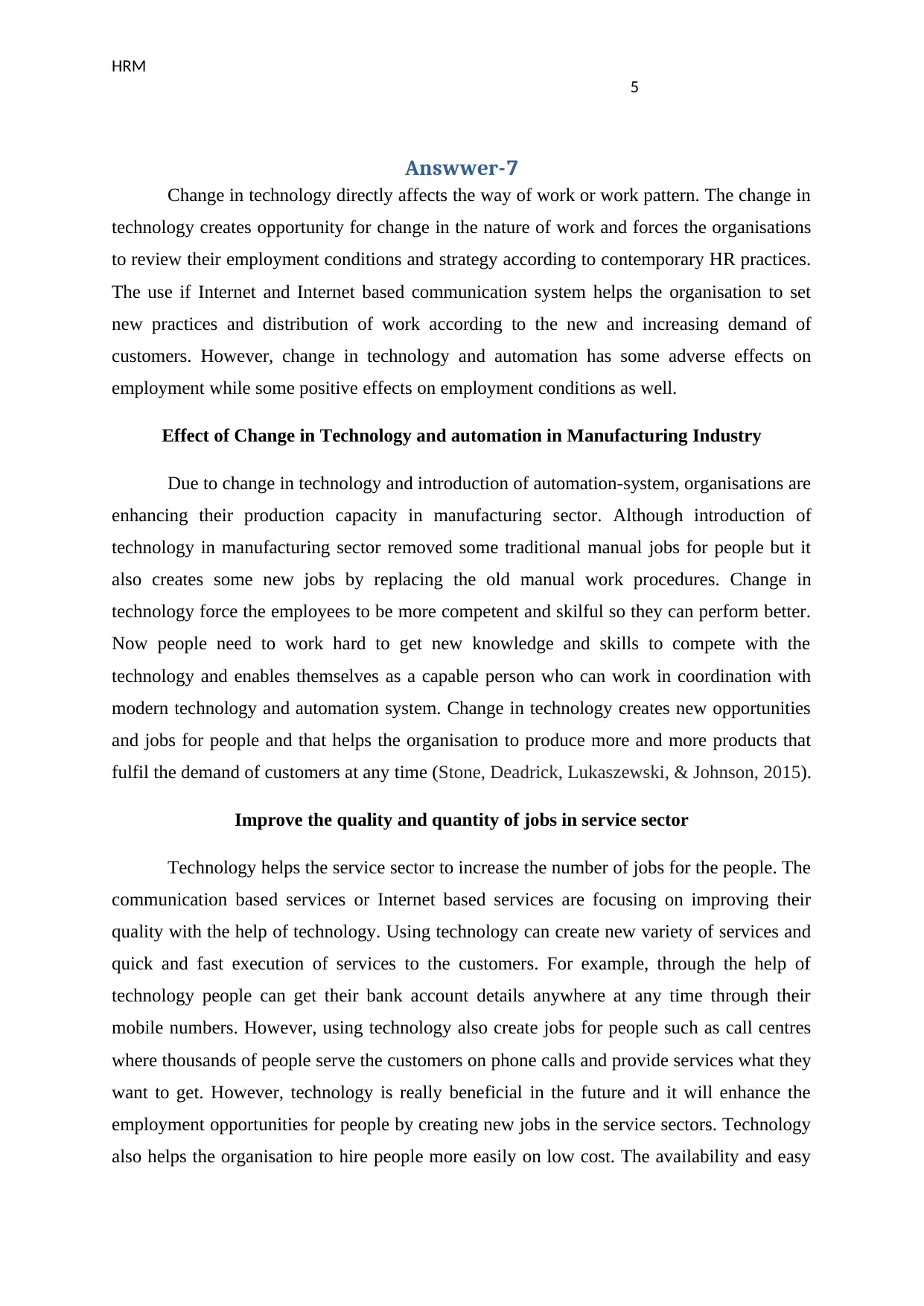
HRM
5
Answwer-7
Change in technology directly affects the way of work or work pattern. The change in
technology creates opportunity for change in the nature of work and forces the organisations
to review their employment conditions and strategy according to contemporary HR practices.
The use if Internet and Internet based communication system helps the organisation to set
new practices and distribution of work according to the new and increasing demand of
customers. However, change in technology and automation has some adverse effects on
employment while some positive effects on employment conditions as well.
Effect of Change in Technology and automation in Manufacturing Industry
Due to change in technology and introduction of automation-system, organisations are
enhancing their production capacity in manufacturing sector. Although introduction of
technology in manufacturing sector removed some traditional manual jobs for people but it
also creates some new jobs by replacing the old manual work procedures. Change in
technology force the employees to be more competent and skilful so they can perform better.
Now people need to work hard to get new knowledge and skills to compete with the
technology and enables themselves as a capable person who can work in coordination with
modern technology and automation system. Change in technology creates new opportunities
and jobs for people and that helps the organisation to produce more and more products that
fulfil the demand of customers at any time (Stone, Deadrick, Lukaszewski, & Johnson, 2015).
Improve the quality and quantity of jobs in service sector
Technology helps the service sector to increase the number of jobs for the people. The
communication based services or Internet based services are focusing on improving their
quality with the help of technology. Using technology can create new variety of services and
quick and fast execution of services to the customers. For example, through the help of
technology people can get their bank account details anywhere at any time through their
mobile numbers. However, using technology also create jobs for people such as call centres
where thousands of people serve the customers on phone calls and provide services what they
want to get. However, technology is really beneficial in the future and it will enhance the
employment opportunities for people by creating new jobs in the service sectors. Technology
also helps the organisation to hire people more easily on low cost. The availability and easy
5
Answwer-7
Change in technology directly affects the way of work or work pattern. The change in
technology creates opportunity for change in the nature of work and forces the organisations
to review their employment conditions and strategy according to contemporary HR practices.
The use if Internet and Internet based communication system helps the organisation to set
new practices and distribution of work according to the new and increasing demand of
customers. However, change in technology and automation has some adverse effects on
employment while some positive effects on employment conditions as well.
Effect of Change in Technology and automation in Manufacturing Industry
Due to change in technology and introduction of automation-system, organisations are
enhancing their production capacity in manufacturing sector. Although introduction of
technology in manufacturing sector removed some traditional manual jobs for people but it
also creates some new jobs by replacing the old manual work procedures. Change in
technology force the employees to be more competent and skilful so they can perform better.
Now people need to work hard to get new knowledge and skills to compete with the
technology and enables themselves as a capable person who can work in coordination with
modern technology and automation system. Change in technology creates new opportunities
and jobs for people and that helps the organisation to produce more and more products that
fulfil the demand of customers at any time (Stone, Deadrick, Lukaszewski, & Johnson, 2015).
Improve the quality and quantity of jobs in service sector
Technology helps the service sector to increase the number of jobs for the people. The
communication based services or Internet based services are focusing on improving their
quality with the help of technology. Using technology can create new variety of services and
quick and fast execution of services to the customers. For example, through the help of
technology people can get their bank account details anywhere at any time through their
mobile numbers. However, using technology also create jobs for people such as call centres
where thousands of people serve the customers on phone calls and provide services what they
want to get. However, technology is really beneficial in the future and it will enhance the
employment opportunities for people by creating new jobs in the service sectors. Technology
also helps the organisation to hire people more easily on low cost. The availability and easy
⊘ This is a preview!⊘
Do you want full access?
Subscribe today to unlock all pages.

Trusted by 1+ million students worldwide
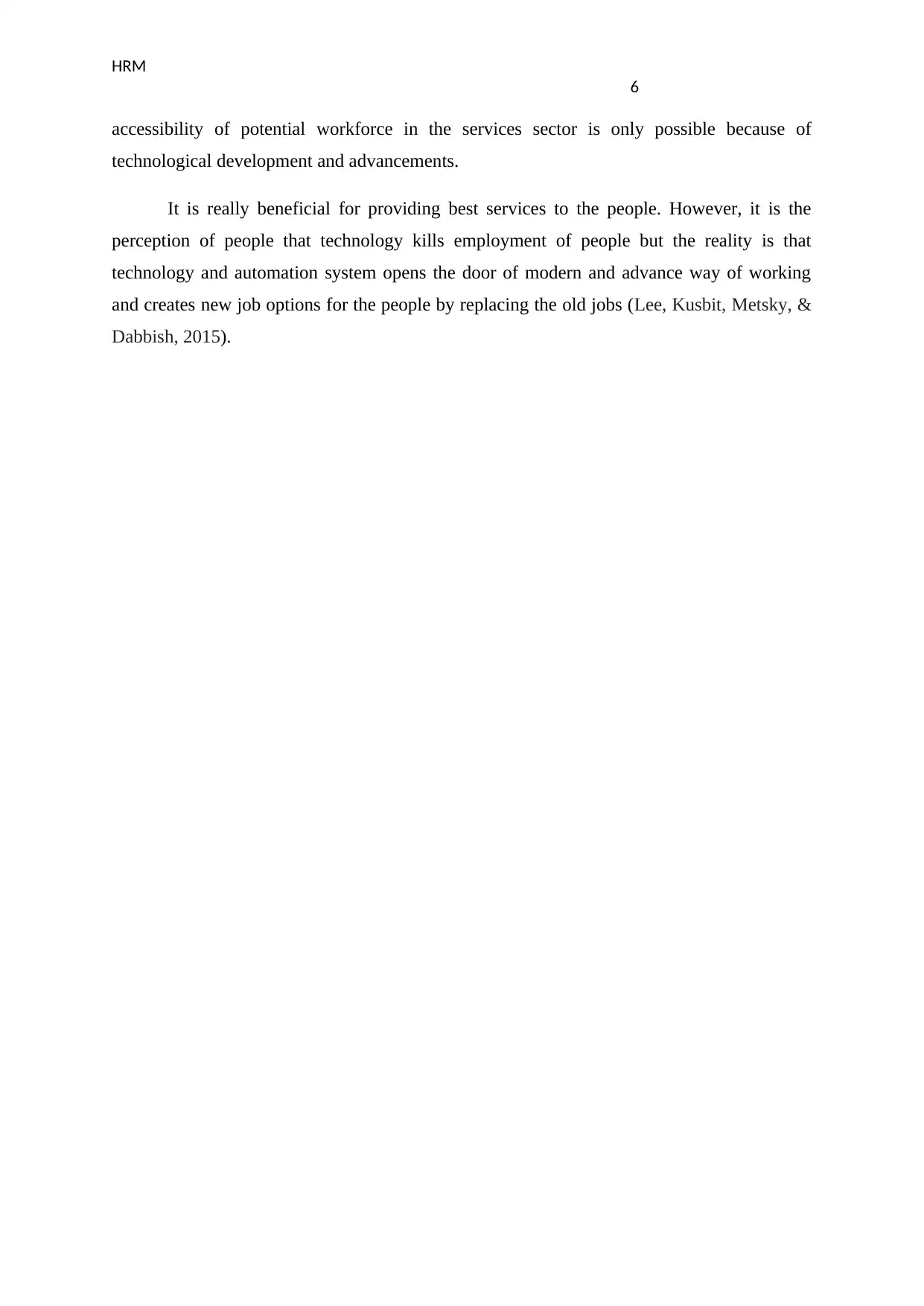
HRM
6
accessibility of potential workforce in the services sector is only possible because of
technological development and advancements.
It is really beneficial for providing best services to the people. However, it is the
perception of people that technology kills employment of people but the reality is that
technology and automation system opens the door of modern and advance way of working
and creates new job options for the people by replacing the old jobs (Lee, Kusbit, Metsky, &
Dabbish, 2015).
6
accessibility of potential workforce in the services sector is only possible because of
technological development and advancements.
It is really beneficial for providing best services to the people. However, it is the
perception of people that technology kills employment of people but the reality is that
technology and automation system opens the door of modern and advance way of working
and creates new job options for the people by replacing the old jobs (Lee, Kusbit, Metsky, &
Dabbish, 2015).
Paraphrase This Document
Need a fresh take? Get an instant paraphrase of this document with our AI Paraphraser
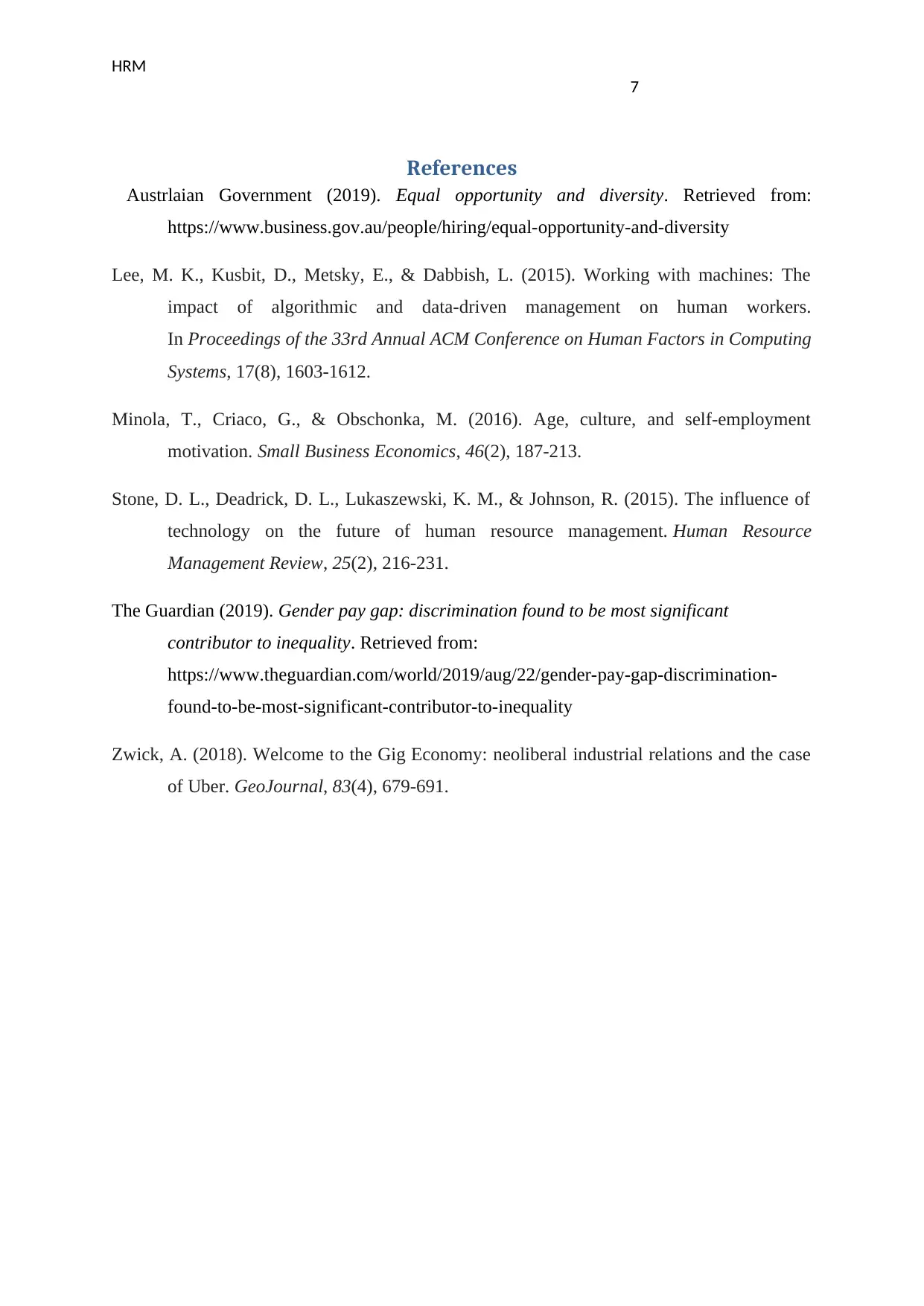
HRM
7
References
Austrlaian Government (2019). Equal opportunity and diversity. Retrieved from:
https://www.business.gov.au/people/hiring/equal-opportunity-and-diversity
Lee, M. K., Kusbit, D., Metsky, E., & Dabbish, L. (2015). Working with machines: The
impact of algorithmic and data-driven management on human workers.
In Proceedings of the 33rd Annual ACM Conference on Human Factors in Computing
Systems, 17(8), 1603-1612.
Minola, T., Criaco, G., & Obschonka, M. (2016). Age, culture, and self-employment
motivation. Small Business Economics, 46(2), 187-213.
Stone, D. L., Deadrick, D. L., Lukaszewski, K. M., & Johnson, R. (2015). The influence of
technology on the future of human resource management. Human Resource
Management Review, 25(2), 216-231.
The Guardian (2019). Gender pay gap: discrimination found to be most significant
contributor to inequality. Retrieved from:
https://www.theguardian.com/world/2019/aug/22/gender-pay-gap-discrimination-
found-to-be-most-significant-contributor-to-inequality
Zwick, A. (2018). Welcome to the Gig Economy: neoliberal industrial relations and the case
of Uber. GeoJournal, 83(4), 679-691.
7
References
Austrlaian Government (2019). Equal opportunity and diversity. Retrieved from:
https://www.business.gov.au/people/hiring/equal-opportunity-and-diversity
Lee, M. K., Kusbit, D., Metsky, E., & Dabbish, L. (2015). Working with machines: The
impact of algorithmic and data-driven management on human workers.
In Proceedings of the 33rd Annual ACM Conference on Human Factors in Computing
Systems, 17(8), 1603-1612.
Minola, T., Criaco, G., & Obschonka, M. (2016). Age, culture, and self-employment
motivation. Small Business Economics, 46(2), 187-213.
Stone, D. L., Deadrick, D. L., Lukaszewski, K. M., & Johnson, R. (2015). The influence of
technology on the future of human resource management. Human Resource
Management Review, 25(2), 216-231.
The Guardian (2019). Gender pay gap: discrimination found to be most significant
contributor to inequality. Retrieved from:
https://www.theguardian.com/world/2019/aug/22/gender-pay-gap-discrimination-
found-to-be-most-significant-contributor-to-inequality
Zwick, A. (2018). Welcome to the Gig Economy: neoliberal industrial relations and the case
of Uber. GeoJournal, 83(4), 679-691.
1 out of 8
Related Documents
Your All-in-One AI-Powered Toolkit for Academic Success.
+13062052269
info@desklib.com
Available 24*7 on WhatsApp / Email
![[object Object]](/_next/static/media/star-bottom.7253800d.svg)
Unlock your academic potential
Copyright © 2020–2025 A2Z Services. All Rights Reserved. Developed and managed by ZUCOL.





